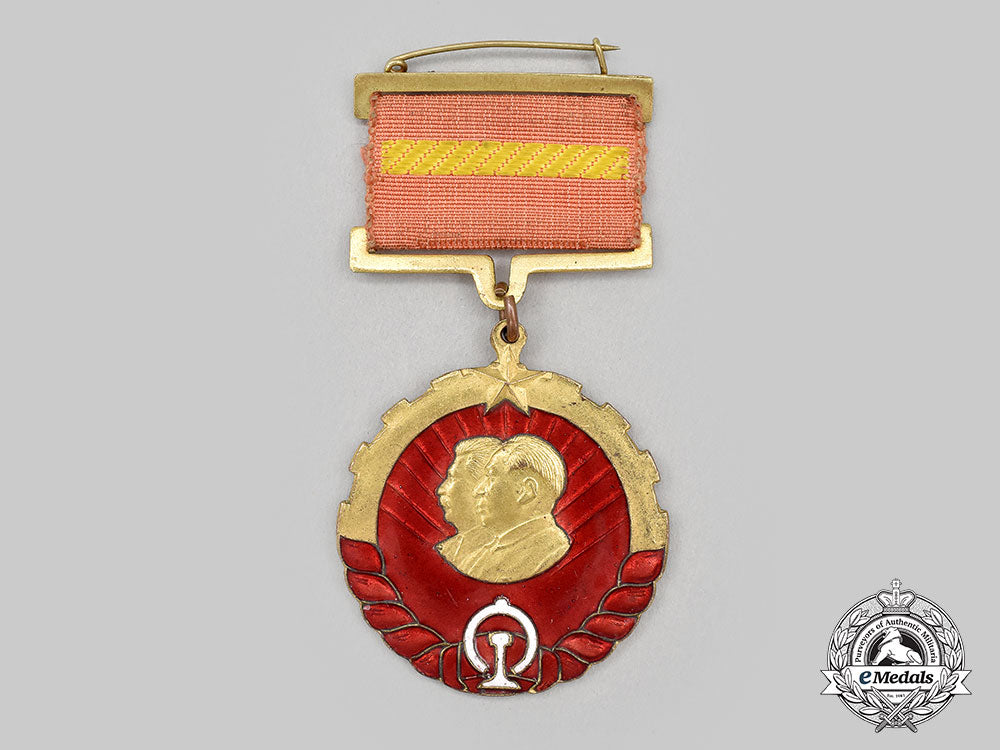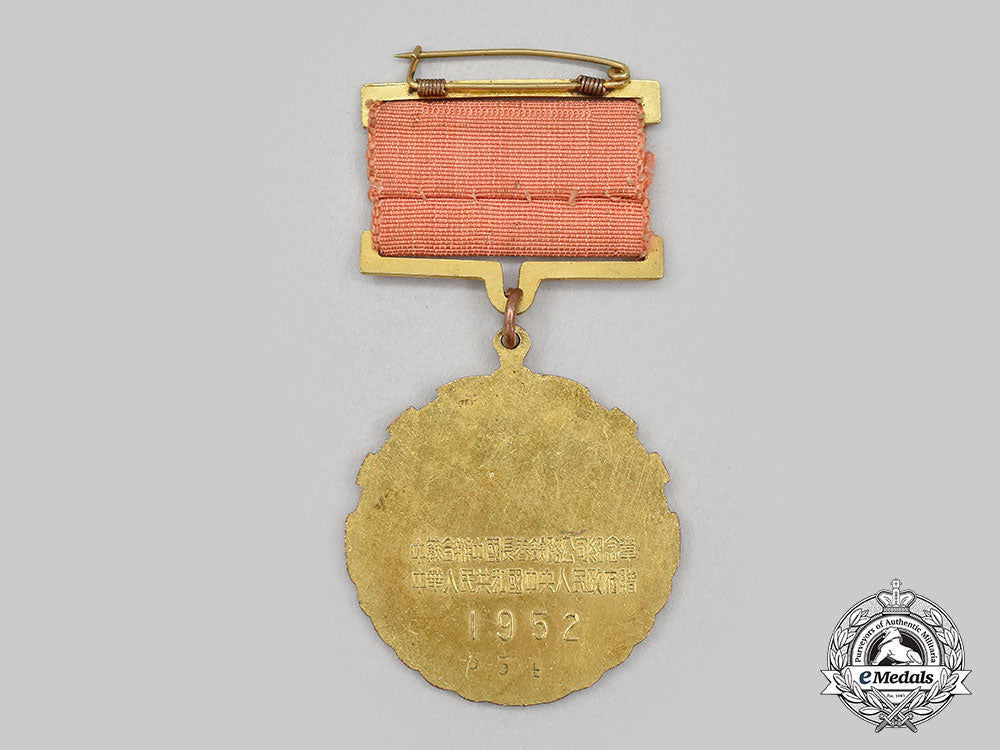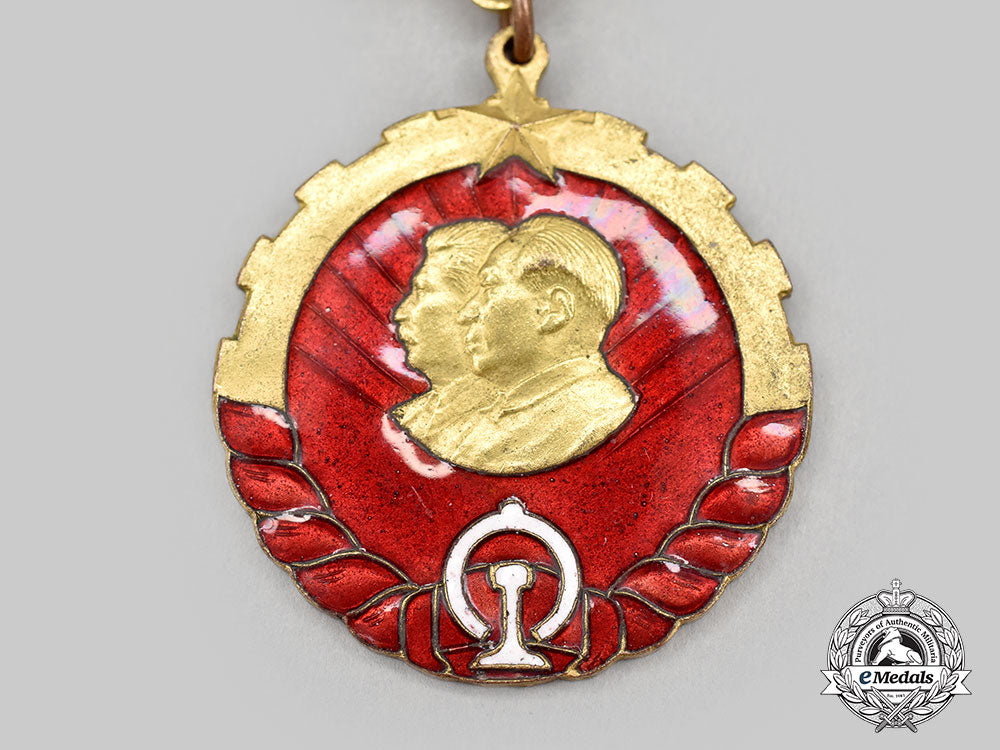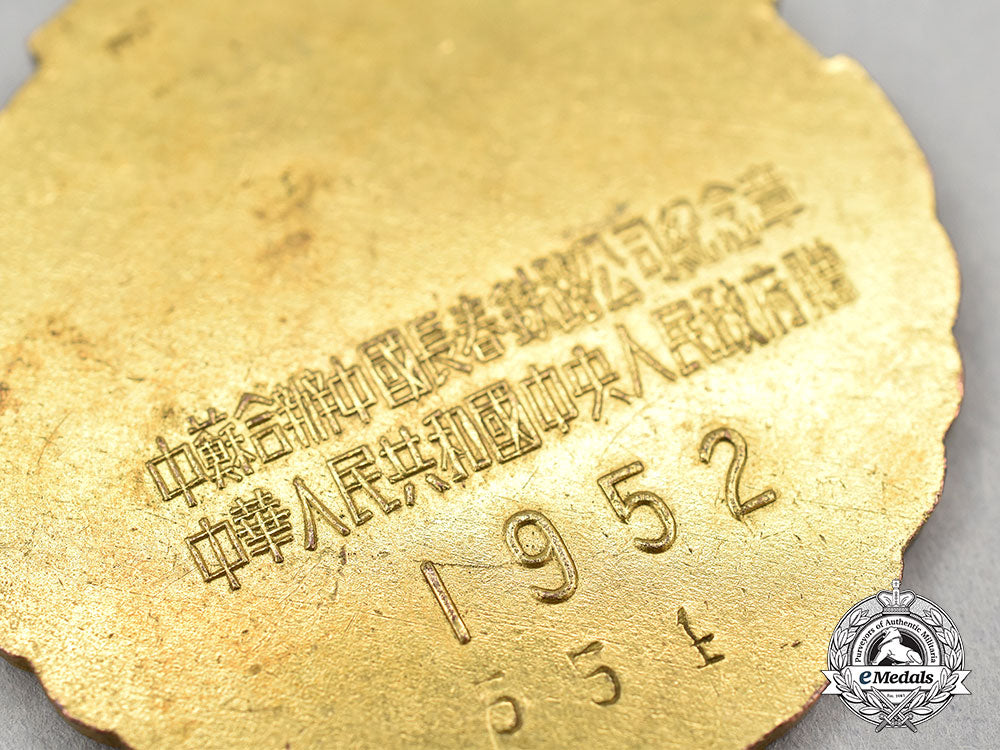
LOADING ...
In response to evolving domestic opinion, eMedals Inc has made the conscious decision to remove the presentation of German Third Reich historical artifacts from our online catalogue. For three decades, eMedals Inc has made an effort to preserve history in all its forms. As historians and researchers, we have managed sensitive articles and materials with the greatest of care and respect for their past and present social context. We acknowledge the growing sentiments put forth by the Canadian public and have taken proactive actions to address this opinion.




China, People's Republic. A Sino-Soviet Medal Of The Changchun Railway Company 1952
China, People's Republic. A Sino-Soviet Medal Of The Changchun Railway Company 1952
SKU: ITEM: EU20630
Current Bid:
Your Max Bid:
Bid History:
Time Remaining:
Couldn't load pickup availability
Shipping Details
Shipping Details
eMedals offers rapid domestic and international shipping. Orders received prior to 12:00pm (EST) will be shipped on the same business day.* Orders placed on Canadian Federal holidays will be dispatched the subsequent business day. Courier tracking numbers are provided for all shipments. All items purchased from eMedals can be returned for a full monetary refund or merchandise credit, providing the criteria presented in our Terms & Conditions are met. *Please note that the addition of a COA may impact dispatch time.
Shipping Details
eMedals offers rapid domestic and international shipping. Orders received prior to 12:00pm (EST) will be shipped on the same business day.* Orders placed on Canadian Federal holidays will be dispatched the subsequent business day. Courier tracking numbers are provided for all shipments. All items purchased from eMedals can be returned for a full monetary refund or merchandise credit, providing the criteria presented in our Terms & Conditions are met. *Please note that the addition of a COA may impact dispatch time.
Description
Description
(长春铁路公司中苏奖章 / Zhǎngchūn tiělù gōngsī zhōng sū jiǎngzhāng). Instituted in 1952. In bronze gilt with red and white enamels, obverse illustrating the left-facing busts of Joseph Stalin and Mao Zedong, the busts surmounted by a star and framed by a half-gear, the China Railway insignia at the base, reverse inscribed in Mandarin "Jointly Run by China and the Soviet Union / Given by the Central People's Government of the People's Republic of China", dated "1952" and number impressed "551" on the reverse, measuring 39.5 mm (w) x 44.8 mm (h) inclusive of its integral ring, intact enamels, very light contact, suspended from a traditional Chinese horizontal hanger incorporating an original ribbon with pinback, near extremely fine.
Footnote: The Chinese Eastern Railway or CER is the historical name for a railway system in Northeast China (also known as Manchuria). The Russian Empire constructed the line from 1897 to 1902 using a concession from the Qing dynasty government of Imperial China. The system linked Chita with Vladivostok in the Russian Far East and with Port Arthur, then an Imperial Russian leased ice-free port. The T-shaped line consisted of three branches: the western branch, now the Harbin-Manzhouli Railway; the eastern branch, now the Harbin-Suifenhe Railway; and the southern branch, now part of the Beijing-Harbin Railway; which intersected in Harbin. Saint Petersburg administered the railway and the concession, known as the Chinese Eastern Railway Zone, from the city of Harbin, which grew into a major rail-hub.
The southern branch of the CER, known as the Japanese South Manchuria Railway from 1906, became a locus and partial casus belli for the Russo-Japanese War of 1904-1905, the 1929 Sino-Soviet Conflict, and the Second Sino-Japanese War of 1937-1945. On December 31, 1952, the Soviet Union returned full control of the Chinese Eastern Railway to the People's Republic of China. The return of the railway marked the first time that the China Eastern Railway (known as the Chinese Changchun Railway at the time) had been under full Chinese control since the railway was constructed in 1898.
The handover of the railway was the result of negotiations between the Soviet Union and the People's Republic of China culminating in the signing of the Sino-Soviet Treaty of Friendship, Alliance and Mutual Assistance. The Friendship Treaty stipulated that the Chinese Changchun Railway (CCR) be handed over to China no later than December 31, 1952. On that date, China received all of the assets of the Chinese Changchun Railway including 3,282.7 kilometers of railway lines, 10,200 railcars, 880 locomotives, power plants, heavy industries, and coal mines as well as houses, medical facilities, and schools. The transfer of this fully operable railway gave the People's Republic of China control over a politically and economically significant rail line.
The Chinese Changchun Railway connected the national railway system to the important ports of Dalian, and Lüshun as well as to international border crossings with the Soviet Union (at Manzhouli and Suifenhe) and to North Korea (at Dandong, Ji'an and Tumen). The history of the Chinese Eastern Railway played an integral role in Sino-Soviet relations throughout the 1950s. The railway was a key part of the negotiations that culminated with the Sino-Soviet Friendship Treaty and marked the high point of Sino-Soviet co-operation. As a crucial transportation link for the country, the Chinese Changchun Railway connected China to the outside world, as well as the factories of the Northeast of China to the agricultural centers outside of Manchuria.
The railway was and still is crucial to China's economic growth as it connects valuable coal and oil fields to the coastal cities, as well as the important cities of Shenyang, Harbin and Dalian. On the political side, the return of the Chinese Eastern Railway was a diplomatic victory for the Chinese Communist Party, gaining Chinese control over an enterprise that was one of the last remnants of European colonization. Furthermore, the return of the railway and associated Friendship Treaty established the era of Sino-Soviet co-operation that would last until the Sino-Soviet split. The railroad would prove valuable during both the Korean War and the military tensions of the Sino-Soviet border conflict as well, by providing the PLA logistical support to the important border cities of Manzhouli and Suifenhe.
Description
(长春铁路公司中苏奖章 / Zhǎngchūn tiělù gōngsī zhōng sū jiǎngzhāng). Instituted in 1952. In bronze gilt with red and white enamels, obverse illustrating the left-facing busts of Joseph Stalin and Mao Zedong, the busts surmounted by a star and framed by a half-gear, the China Railway insignia at the base, reverse inscribed in Mandarin "Jointly Run by China and the Soviet Union / Given by the Central People's Government of the People's Republic of China", dated "1952" and number impressed "551" on the reverse, measuring 39.5 mm (w) x 44.8 mm (h) inclusive of its integral ring, intact enamels, very light contact, suspended from a traditional Chinese horizontal hanger incorporating an original ribbon with pinback, near extremely fine.
Footnote: The Chinese Eastern Railway or CER is the historical name for a railway system in Northeast China (also known as Manchuria). The Russian Empire constructed the line from 1897 to 1902 using a concession from the Qing dynasty government of Imperial China. The system linked Chita with Vladivostok in the Russian Far East and with Port Arthur, then an Imperial Russian leased ice-free port. The T-shaped line consisted of three branches: the western branch, now the Harbin-Manzhouli Railway; the eastern branch, now the Harbin-Suifenhe Railway; and the southern branch, now part of the Beijing-Harbin Railway; which intersected in Harbin. Saint Petersburg administered the railway and the concession, known as the Chinese Eastern Railway Zone, from the city of Harbin, which grew into a major rail-hub.
The southern branch of the CER, known as the Japanese South Manchuria Railway from 1906, became a locus and partial casus belli for the Russo-Japanese War of 1904-1905, the 1929 Sino-Soviet Conflict, and the Second Sino-Japanese War of 1937-1945. On December 31, 1952, the Soviet Union returned full control of the Chinese Eastern Railway to the People's Republic of China. The return of the railway marked the first time that the China Eastern Railway (known as the Chinese Changchun Railway at the time) had been under full Chinese control since the railway was constructed in 1898.
The handover of the railway was the result of negotiations between the Soviet Union and the People's Republic of China culminating in the signing of the Sino-Soviet Treaty of Friendship, Alliance and Mutual Assistance. The Friendship Treaty stipulated that the Chinese Changchun Railway (CCR) be handed over to China no later than December 31, 1952. On that date, China received all of the assets of the Chinese Changchun Railway including 3,282.7 kilometers of railway lines, 10,200 railcars, 880 locomotives, power plants, heavy industries, and coal mines as well as houses, medical facilities, and schools. The transfer of this fully operable railway gave the People's Republic of China control over a politically and economically significant rail line.
The Chinese Changchun Railway connected the national railway system to the important ports of Dalian, and Lüshun as well as to international border crossings with the Soviet Union (at Manzhouli and Suifenhe) and to North Korea (at Dandong, Ji'an and Tumen). The history of the Chinese Eastern Railway played an integral role in Sino-Soviet relations throughout the 1950s. The railway was a key part of the negotiations that culminated with the Sino-Soviet Friendship Treaty and marked the high point of Sino-Soviet co-operation. As a crucial transportation link for the country, the Chinese Changchun Railway connected China to the outside world, as well as the factories of the Northeast of China to the agricultural centers outside of Manchuria.
The railway was and still is crucial to China's economic growth as it connects valuable coal and oil fields to the coastal cities, as well as the important cities of Shenyang, Harbin and Dalian. On the political side, the return of the Chinese Eastern Railway was a diplomatic victory for the Chinese Communist Party, gaining Chinese control over an enterprise that was one of the last remnants of European colonization. Furthermore, the return of the railway and associated Friendship Treaty established the era of Sino-Soviet co-operation that would last until the Sino-Soviet split. The railroad would prove valuable during both the Korean War and the military tensions of the Sino-Soviet border conflict as well, by providing the PLA logistical support to the important border cities of Manzhouli and Suifenhe.




You May Also Like
Germany, SA. A Model 1933 Service Dagger, SA-Gruppe Nordsee, by Friedrich von der Kohlen
G59818
Germany, SA. A Model 1933 Service Dagger, SA-Gruppe Pommern, by Gustav Wirth
G59816
Germany, Third Reich. A Mixed Lot of Tyrolean Marksmanship Badges
G52930
Germany, SS. An Estonian Waffen-SS Volunteer’s Sleeve Shield
G50381
Germany, SS. A Waffen-SS Sturmmann Sleeve Insignia
G52846
-
Germany, SA. A Model 1933 Service Dagger, SA-Gruppe Nordsee, by Friedrich von der Kohlen
G59818
Add to CartRegular price $980 USDRegular price $0 USD Sale price $980 USDUnit price / per -
Germany, SA. A Model 1933 Service Dagger, SA-Gruppe Pommern, by Gustav Wirth
G59816
Add to CartRegular price $980 USDRegular price $0 USD Sale price $980 USDUnit price / per -
Germany, Third Reich. A Mixed Lot of Tyrolean Marksmanship Badges
G52930
Add to CartRegular price $135 USDRegular price $0 USD Sale price $135 USDUnit price / per -
Germany, SS. An Estonian Waffen-SS Volunteer’s Sleeve Shield
G50381
Add to CartRegular price $150 USDRegular price $0 USD Sale price $150 USDUnit price / per -
Germany, SS. A Waffen-SS Sturmmann Sleeve Insignia
G52846
Add to CartRegular price $135 USDRegular price $0 USD Sale price $135 USDUnit price / per
Do you have a similar item you are interested in selling?
Please complete the form and our client care representatives will contact you.
Sell Item












